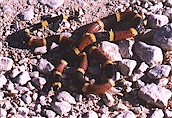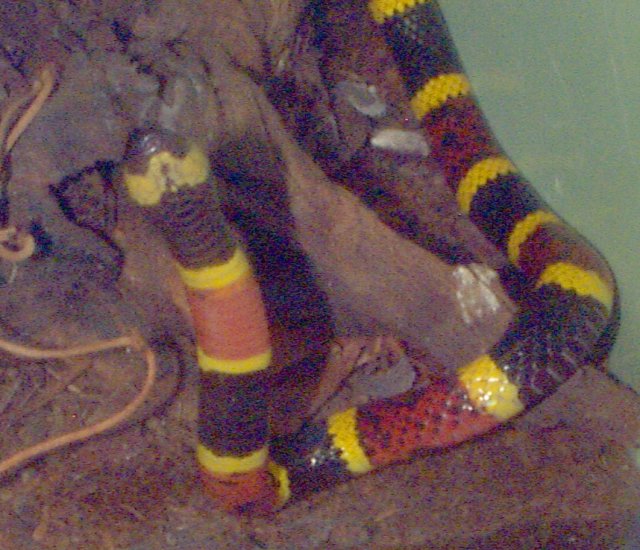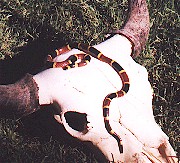Coral Snakes
SPECIFIC INFORMATION
- Scientific Name: Micrurus fulvius tenere
- Range: Southeastern United States and into Mexico
- Habitat: Ranging from wet rocky areas to wet grassy and forested areas
- Status: Not Threatened
- Diet in the Wild: Carnivorous Diet of small snakes, lizards, and amphibians
- Diet in the Zoo: Carnivorous Diet
- Location in Zoo: Herpetarium
Micrurus fulvius tenere or better known as the common Coral snake, is a beautiful creature, but should be feared for its deadly potential.
Courtesy of Bayou BobThe Coral snake is a venomous snake, but it is not a viper like many venomous snakes. It is an elapid. It has short, fixed fangs that secrete its neurotoxic venom instead of pumping it through long hollow fangs as the vipers do. The snake's diet of small snakes, lizards, and amphibians is a must for such a thin snake. The snake bites and must hold on tightly to its prey for the venom to make its way into the body of the unfortunate victim. The Coral Snake then swallows the subdued prey whole.

Courtesy of Bayou BobSpecial anatomical, physiological or behavioral adaptations
The Snake has vibrant colors to ward off would be predators. The Coral Snake is the only venomous snake in North America to hatch its young from eggs. In the case of self-defense, the snake has very potent venom strong enough to kill a man. But because it is an elapid and must hold on tight to deliver its venom, it is less likely to cause a fatal wound. When the snake is disturbed, it lays its head out of sight, rattles its flattened out elevated tail, and creates a popping sound with its vent lining. One must be careful to watch carefully for the bright colors of the coral snake. There are a few species of snakes that mimic the coral snakes pattern hoping that prey will mistake them for the Coral Snake. Some of these common mimics include:
- Milk Snakes
- Corn Snakes
- And a multitude of others
Personal Notes
I have encountered a coral snake in the wild and was at first drawn
to it for its beautiful colors, but soon realized what a dangerous
animal it was. I left the scene imediately hoping it would not follow.
Snakes are not hostile creatures and with a little bit of care,
we can all admire even the most dangerous creatures without any worries.
I hope that you have the opportunity to see a coral snake at a local zoo
where you can admire it in safety.For more information, visit:
Bayou Bob's Rattlesnake Ranch
WORKS CITED
Herbert Zim, Hobart Smith. Reptiles and Amphibians. Western
Publishing company Inc. : Racine, Wisconson,1956.Coral Snake. World Book Encyclopedia. Vol 4, p 1051.
World Book, Inc.: Chicago, 1990.Bayou Bob's Rattlesnake Ranch (see above link),
one of the most comprehensive animal sites on the web!Special thanks to Adam Harrison for his instruction on how to write html.



